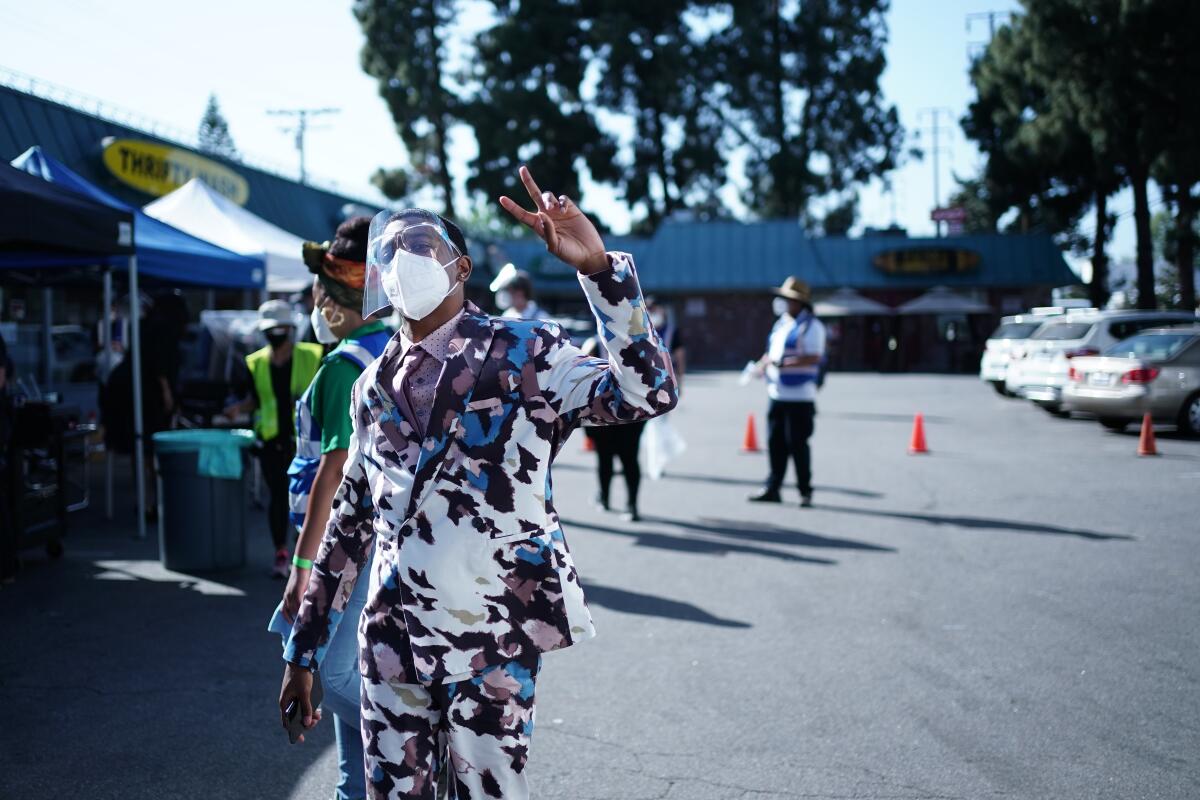How is reopening affecting Hollywood film and TV sets? 5 key takeaways

- Share via
As California officially reopened its economy on Tuesday, many businesses hammered by the coronavirus breathed a collective sigh of relief.
The news was especially welcome in the film and TV industry, which was hard hit by the economic fallout from the pandemic.
This week, the Los Angeles County Department of Public Health revoked its health order mandating certain safety protocols for film and television productions.
Production remains hampered by restrictions necessary for keeping the COVID-19 pandemic at bay, but filmmakers and studios are optimistic that Hollywood is finally reopening.
That means independent and other nonunion productions — reality TV shows, commercials or photography shoots — will no longer have to abide by previous L.A. County testing and social distancing mandates intended to reduce the spread of coronavirus infections. Instead, they will be subject to the California Occupational Safety and Health Standards Board’s workplace regulations, just like any other business.
The shutdown caused by the COVID-19 pandemic last spring devastated local crews and vendors such as prop houses and caterers. Nearly 300,000 jobs were lost in creative industries in California, according to one estimate.
Although productions were allowed to resume last summer — a controversial decision in light of the ban on outdoor dining and other activities — filmmakers faced mounting costs and lost insurance coverage.
Here’s a primer on what the reopening means for Southern California’s highest-profile industry:
Now that the state’s economy has reopened, will it be back to business as usual for the film crews?
Not exactly. Although California is allowing businesses to reopen without the kind of restrictions, such as social distancing and mask wearing, that have been in place for a year, most film productions won’t be making big changes in how they operate, at least not immediately. That’s because unionized crews — which work on the vast majority of shoots — are still subject to the same safety protocols, which expire at the end of this month.
The agreement negotiated last fall includes a detailed list of safety measures and calls for cast and crew to be compensated for time taken for testing or quarantines. With looser mandates for testing from the county health department, some of those requirements likely will be dropped.
But much will depend on the outcome of negotiations that soon get underway between the major entertainment industry unions and the Alliance of Motion Pictures and Television Producers, which represents the major production companies.
What are the sticking points in these negotiations?
Cal/OSHA this week approved a plan that would allow most fully vaccinated workers in many workplaces to stop wearing masks and end physical distancing requirements for all workers in some situations.
But many of the protocols set by unions and producers could stay in place. Complicating matters is that some infectious-disease experts are concerned about a highly contagious Delta variant of the virus and reports of some cases of vaccinated people contracting COVID-19.
A big question for many crew members is whether they will be required to be vaccinated.
Eager to keep insurance costs down, some producers have already asked SAG-AFTRA and other unions for permission to require all cast and crew to be vaccinated. Actors, who have to perform in front of the camera with no physical protection equipment, are most at risk.
While an industrywide mandate is considered unlikely, the union is considering whether to agree to a vaccination requirement on a production-by-production basis, according to one person familiar with the talks who was not authorized to comment. Unions, however, will draw the line at making vaccinations a requirement for hiring, this person said.
In the wake of the pandemic, the entertainment industry created a new position on set to help keep outbreaks at bay.
So what’s the most likely outcome?
Although it’s uncertain what the sides will agree, a number of restrictions will likely be eased. Extensive safety protocols undoubtedly have saved lives but they’ve also been costly to producers, so expect some compromise.
For example, testing probably will remain but there might be reduction in the frequency of testing requirements for those who are vaccinated. Under current rules, those in the zones of the set where actors are present, or crew members who have to work in close confines, are tested three times a week or more.
Also, expect some easing on masking and social distancing rules. After all, wearing a mask for more than 10 hours a day in the California heat is tough going for crew. Remote casting and individually packaged meals are among some of the practices that could remain.
Sanitation protocols won’t go away but also are likely to be scaled back. Instead of disinfecting gear, surfaces and transporters multiple times a day, maybe just once a day could be sufficient. Additionally, sick pay for those who have symptoms or need to be tested probably will remain.
What effect will these changes have on local production?
Even before this week, productions rebounded as the film industry anticipated an easing of restrictions. The L.A. region generated 3,442 shoot days for location filming in April, up from 3,384 shoot days in April 2019, according to data from FilmLA, the nonprofit group that handles film permits for city and county (one shoot day is defined as one crew’s permission to film at one or more locations during a 24-hour period). Already, film executives say finding crew and film stage space is becoming difficult.
“I think anticipating the news was so clear that the state was going to lift restrictions in June, people came back,” said FilmLA President Paul Audley.
FilmLA is encouraging productions to follow the new health officer order, but it will no longer be part of the permitting process, Audley said.
During the height of the pandemic, many producers turned to countries such as the U.K. and New Zealand to film. Will that continue?
Maybe not, at least not to the same degree.
Says Audley: “Some of the other key places that larger productions might have gone, like England [and] Australia — that have very, very high value tax credits or refunds or grants — they’re still in tough shape and still under severe restrictions. We’ve seen some of the folks that might have migrated elsewhere for filming are sticking close to home.”
More to Read
Inside the business of entertainment
The Wide Shot brings you news, analysis and insights on everything from streaming wars to production — and what it all means for the future.
You may occasionally receive promotional content from the Los Angeles Times.











